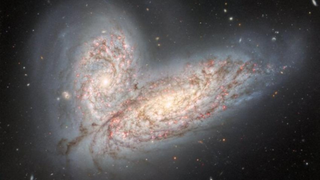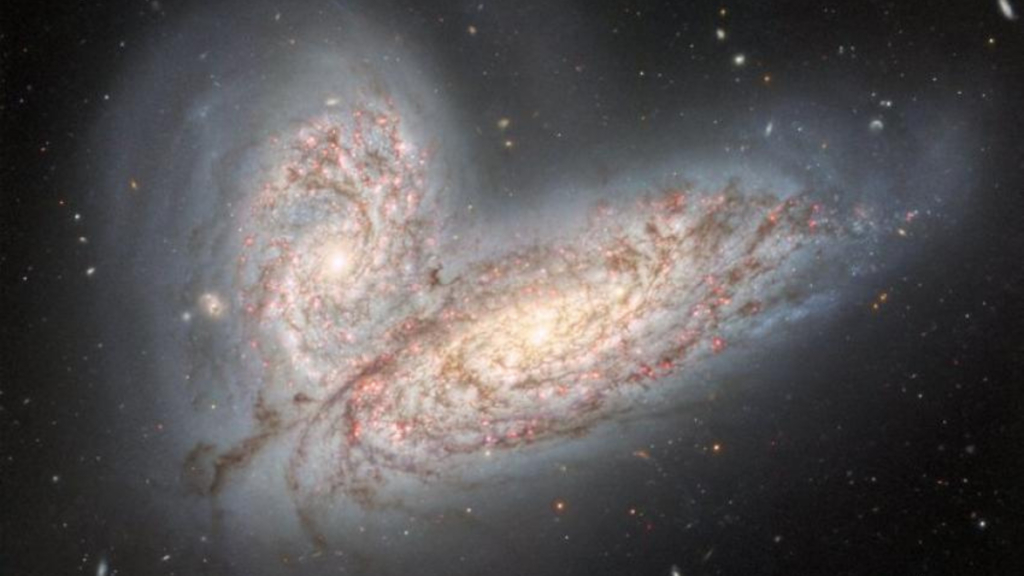
The clashing galaxies NGC 4568 (bottom) and NGC 4567 (top) as seen by the Gemini North telescope in Hawai‘i
(Image credit: International Gemini Observatory/NOIRLab/NSF/AURA Image processing: T.A. Rector (University of Alaska Anchorage/NSF’s NOIRLab), J. Miller (Gemini Observatory/NSF’s NOIRLab), M. Zamani (NSF’s NOIRLab) & D. de Martin (NSF’s NOIRLab))
Eventually, all galaxies, including our own Milky Way, will meet their end.
But how do galaxies die? If you’re in the mood to destroy an entire galaxy, you have several options, depending on your desired level of destructiveness.
Related: Monster black holes may have murdered their host galaxies in the early universe
Option 1: Wake up the monster black hole
At the heart of almost every galaxy sits a supermassive black hole. In the case of the Milky Way, we have Sagittarius A*, a beast weighing more than 4.5 million suns. Usually, these giant black holes are quiet and dormant, just sipping on whatever bits of gas or stars that wander too close. But occasionally, they feast on a much larger meal. When they do, that gas swirls around them and compresses, reaching temperatures well over a billion degrees.
Those ridiculously high temperatures cause the gas to give off an enormous amount of radiation that then goes out to flood the entire galaxy, heating up any reserves of gas and preventing the formation of new stars. While things usually calm down after that, in the worst cases, the radiation from the vicinity of the black hole can outright eject massive amounts of gas from the galaxy altogether.
This doesn’t quite destroy a galaxy, but it does effectively kill it by preventing new stars from forming for a very long time and, in some cases, forever.
Option 2: Drop it into a cluster
Galaxy clusters are the dense urban centers of the cosmos, usually home to a thousand or more galaxies. But these clusters contain more than just galaxies; they also hold vast reservoirs of a hot, thin gas known as the intracluster medium (ICM).
Breaking space news, the latest updates on rocket launches, skywatching events and more!
The ICM is so thin that it would register as a vacuum in laboratories on Earth. But when galaxies fall into a cluster, they still have to swim through it. Initially, this leads to a brief round of star formation as shock waves compress gas clouds throughout the galaxy. But eventually, the pressure from the gas does its work, picking pieces of gas off the galaxy like debris flying off a meteorite.
This leads to a cute situation known as “jellyfish galaxies,” so called because the stripped gas resembles the tentacles of a jellyfish. Although most galaxies survive their descent into a cluster’s ICM, some smaller galaxies get completely evaporated.
The Hubble Space Telescope captured an edge-on view of JW100 — a jellyfish galaxy (located in the lower right of the image) — along with six small elliptical galaxies and a much larger elliptical galaxy at the top of the frame. (Image credit: ESA/Hubble & NASA, M. Gullieuszik and the GASP team)
Option 3: Crash it into another galaxy
Galaxy collisions represent one of the greatest releases of energy in the known universe, and that means it’s not exactly a pretty sight. Our own Milky Way will collide with our neighboring galaxy Andromeda in about 5 billion years.
A slow and aching process lasting hundreds of millions of years, galaxy mergers can raise huge tidal tails that consist of streams of broken-off stars and gas that arch around the galaxies. During the collision and merger, countless stars are lost through random interactions. And once the respective supermassive black holes meet, a fresh round of radiation pummels the newly merged galaxy. The combined devastation depletes the galaxy of gas reservoirs, effectively shutting off star formation for good.
Option 4: Feed it to a much bigger galaxy
If a smaller galaxy and a much larger companion merge, it can spell the end of the smaller galaxy. Indeed, the European Space Agency’s Gaia survey has discovered the bones and corpses of cannibalized galaxies littered throughout the Milky Way.
One such example is known as the Gaia sausage. This collection of stars scattered around the Milky Way’s core share properties, like an abundance of heavy elements and orbital parameters, that are distinct from the rest of the population. Astronomers think the stars in the Gaia sausage are the tattered remnants of a small dwarf galaxy that was torn apart by its merger with the greater Milky Way.
Astronomers have identified dozens of other such collections, streams, clumps and remnants — a sign of the violent merger history of any decently sized galaxy like our own.
Option 5: Just wait
Eventually, time will do its work. Galaxies are remarkably stable; many have existed for well over 10 billion years. But nothing lasts forever.
Far, far into the future, when the universe is many times older than it is today, the merged Milky Way-Andromeda galaxy will begin to dissolve. It’s simply a matter of gravitational chance. Most stars spend most of their lives nowhere near each other, but occasionally, they wander too close. When they do, they perform a little gravitational dance, sending them in new directions. Very rarely, one can get enough energy to escape the galaxy altogether.
This is incredibly rare, but after trillions upon trillions of years, it’s bound to happen. Eventually, everything in our galaxy will either make its way inside a giant black hole or be scattered into the wider universe. And that will truly be the end of our galaxy.
Join our Space Forums to keep talking space on the latest missions, night sky and more! And if you have a news tip, correction or comment, let us know at: community@space.com.
Paul M. Sutter is an astrophysicist at SUNY Stony Brook and the Flatiron Institute in New York City. Paul received his PhD in Physics from the University of Illinois at Urbana-Champaign in 2011, and spent three years at the Paris Institute of Astrophysics, followed by a research fellowship in Trieste, Italy, His research focuses on many diverse topics, from the emptiest regions of the universe to the earliest moments of the Big Bang to the hunt for the first stars. As an “Agent to the Stars,” Paul has passionately engaged the public in science outreach for several years. He is the host of the popular “Ask a Spaceman!” podcast, author of “Your Place in the Universe” and “How to Die in Space” and he frequently appears on TV — including on The Weather Channel, for which he serves as Official Space Specialist.
>>> Read full article>>>
Copyright for syndicated content belongs to the linked Source : Space.com – https://www.space.com/how-are-galaxies-destroyed
